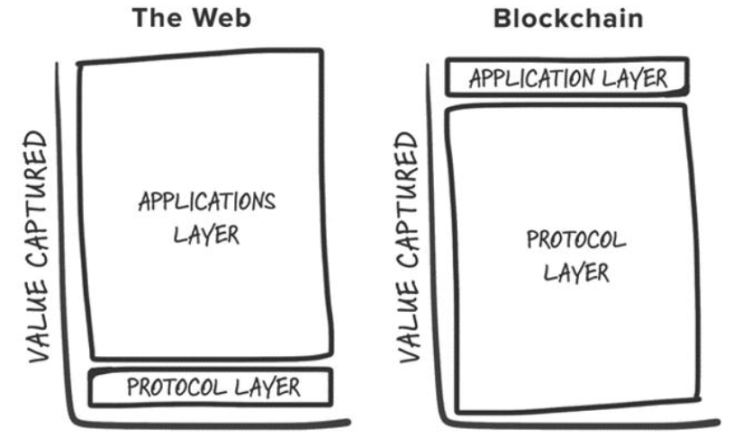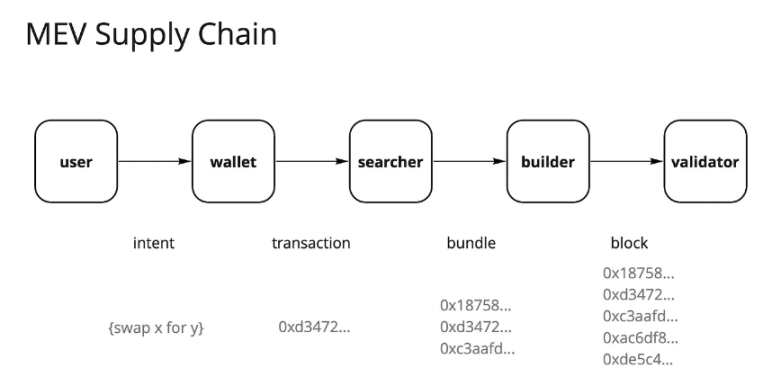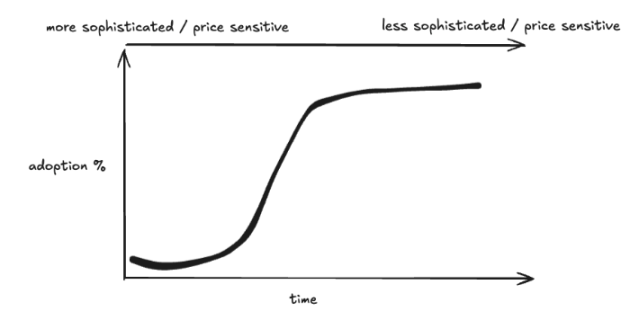Ucapkan selamat tinggal pada demam infrastruktur dan sambut zaman keemasan aplikasi?
Original author: Adrian
Terjemahan asli: Luffy, Berita Pandangan ke Depan
The greatest returns on investment in every crypto cycle throughout history have been achieved by betting early on new underlying infrastructure primitives (PoW, smart contracts, PoS, high throughput, modularity, etc.). If we look at the top 25 tokens on Coingecko, we see that there are only two that are not native to L1 blockchains (excluding pegged assets): Uniswap and Anjing Shiba Inu. This phenomenon was first theorized in 2016 by Joel Monegro, who proposed the Fat Protocol Theory . Monegro believes that the biggest difference between Web3 and Web2 in terms of value accumulation is that the value accumulated by the cryptocurrency base layer is greater than the sum of the value captured by the applications built on it, and the value comes from:
-
Blockchains feature a shared data layer on which transactions are settled, promoting positive-sum competition and enabling permissionless composability.
-
Token appreciation -> introduction of speculative participants -> initial speculators converted into users -> users + token appreciation attract developers and more users, etc. This path forms a positive flywheel.
Fast forward to 2024, the original argument has survived numerous industry debates, and there have been several structural changes in industry dynamics that challenge the original claims of the Fat Protocol Theory:
1. Commoditization of block space: With Ethereum block space at a premium, competitive L1s have risen and become asset class definers. Competitive L1s are often valued in the billions of dollars, and builders and investors are attracted to competitive L1s almost every cycle. New differentiated blockchains emerge in each cycle, which excite investors and users but eventually become ghost chains (such as Cardano). Although there are exceptions, in general, this has led to an overabundance of block space in the market without enough users or applications to support it.
2. Modularity of the base layer: As the number of specialized modular components increases, the definition of base layer becomes increasingly complex, not to mention the value generated by deconstructing each layer of the stack. However, in my opinion, this shift is certain:
-
Value in a modular blockchain is decentralized across the stack, and for a single component (e.g. Celestia) to receive a higher valuation than the integrated base layer requires its component (e.g. DA) to become the most valuable component in the stack and have “applications” built on top of it that have more usage and fee revenue than the integrated system;
-
Competition between modular solutions drives cheaper execution/data availability solutions, further reducing costs for users
3. Towards a chain abstraction future: Modularity inherently creates fragmentation in the ecosystem, leading to cumbersome user experiences. For developers, this means too many choices for where to deploy applications; for users, this means overcoming many obstacles to go from application A on chain X to application B on chain Y. Fortunately, many of our smart people are building a new future where users can interact with crypto applications without knowing the underlying chain. This vision is called chain abstraction. The question now is, where will value accrue in the chain abstract future?
I believe crypto applications are the primary beneficiaries of the shift in how we build infrastructure. Specifically, intent-centric trading supply chains, with order flow exclusivity and intangible assets such as user experience and brand, will increasingly become the moat for killer applications, allowing them to be commercialized much more efficiently than today.
Exclusivity of Order Flow
Since the Ethereum merger and the introduction of Flashbots and MEV-Boost, the MEV landscape has changed dramatically. The dark forest once dominated by searchers has now evolved into a partially commoditized order flow market, and the current MEV supply chain is mainly dominated by validators, who capture about 90% of MEV in the form of bids from every participant in the supply chain.
Ethereum’s MEV Supply Chain
Most participants in the trading supply chain are unhappy that validators capture the majority of extractable value from order flow. Users want to be compensated for generating order flow, applications want to retain value from users order flow, and searchers and builders want greater profits. As a result, value-seeking participants have adapted to this change and have tried multiple strategies to extract alpha, one of which is searcher-builder integration. The idea is that the higher the certainty of inclusion of a searchers packaged block, the higher the profit. A large amount of data and literature shows that exclusivity is the key to capturing value in a competitive market, and the applications with the most valuable traffic will have pricing power.
This is similar to Robinhood’s business model. Robinhood sells order flow to market makers and gets rebates to maintain a “zero-fee” trading model. Pasar makers like Citadel are willing to pay for order flow because they can profit from arbitrage and information asymmetry.
This is further evident in the increasing number of transactions being conducted through private mempools, which recently hit an all-time high of 30% share on Ethereum. Applications realize that the value of all user order flow is extracted and leaked into the MEV supply chain, and private transactions allow for more customizability and commercialization around sticky users.
https://x.com/mcutler/status/1808281859463565361
As the era of chain abstraction arrives, I expect this trend to continue. Under an intent-centric execution model, the trading supply chain is likely to become more fragmented, with applications directing their order flow to the network of solvers that can provide the most competitive execution, driving solver competition to drive down profit margins. However, I expect the majority of value capture to move from the base layer (validators) to the user-facing layers, with middleware components being valuable but with low profit margins. Frontends and applications that can generate valuable order flow will have pricing power over seekers/solvers.
Possible ways to accumulate value in the future
We are already seeing this happening today, with lending protocols reclaiming liquidation bid order flow that would otherwise go to validators, leveraging niche order flow from application-specific ordering (e.g. oracle extractable value auctions, Pyth, API 3, UMA Oval).
User Experience and Brand as Sustainable Moats
If we further break down the 30% of private transactions mentioned above, most of them come from frontends such as TG Bots, Dexes, and wallets:
Despite the long-held belief that crypto-native users have a short attention span, we are finally seeing some level of retention. Both branding and user experience can be a meaningful moat.
User experience: Alternative front-ends that introduce a completely new experience by connecting a wallet on a web application will undoubtedly attract the attention of users who require a specific experience. A good example is Telegram bots such as BananaGun and BONKbot, which have generated $150 million in fees and allow users to trade Memecoin from the comfort of a Telegram chat.
Brand: Well-known brands in the crypto space can increase fees by earning the trust of users. It is well known that fees for in-wallet app swaps are very high, but they are a killer business model because users are willing to pay for convenience. For example, MetaMask swaps generate more than $200 million in fees per year. Uniswap Labs front-end fee swaps have netted $50 million since launch, and transactions that interact with Uniswap Labs contracts in any way other than the official front-end do not charge this fee, but Uniswap Labs revenue is still growing.
This suggests that the Lindy Effect in applications is consistent with or even more pronounced than in infrastructure. Typically, the adoption of new technologies (including cryptocurrencies) follows a sort of S-curve, where as we move from early adopters to mainstream users, the next wave of users will be less sophisticated and therefore less price sensitive, allowing brands that are able to achieve critical mass to monetize in creative ways.
The S Curve of Cryptocurrency
Kesimpulan
As a crypto practitioner who focuses primarily on infrastructure research and investments, this post is by no means a denial of the value of infrastructure as an investable asset class in crypto, but rather a shift in mindset when thinking about entirely new categories of infrastructure. These infrastructure categories enable the next generation of applications to serve users above the S curve. New infrastructure primitives need to bring entirely new use cases at the application level to attract enough attention. At the same time, there is enough evidence that there are sustainable business models at the application level where user ownership directly guides the accumulation of value. Unfortunately, we may have passed the market stage of L1, where betting on every new shiny L1 will bring exponential returns, although those with meaningful differentiation may still be worth investing in.
Even so, I spent a lot of time thinking about and understanding different “infrastructures”:
-
Artificial Intelligence: An agent economy that automates and improves the end-user experience, a compute and inference pasar that continuously optimizes resource allocation, and a validation stack that extends the compute capabilities of blockchain virtual machines.
-
CAKE stack: Many of my points above indicate that I believe we should be moving towards a future of chain abstraction, while the design choices for most components in the stack remain large. As infrastructure supports chain abstraction, the design space for applications will naturally grow and may cause the distinction between application/infrastructure to become blurred.
-
DePIN: I have believed for some time that DePIN is the killer real-world use case for cryptocurrency (second only to stablecoins), and that has never changed. DePIN leverages everything that cryptocurrency is good at: permissionless coordination of resources through incentives, bootstrapping markets, and decentralized ownership. While each specific type of DePIN network still has specific challenges to solve, validating a solution to the cold start problem is huge, and I am very excited to see founders with industry expertise bringing their products to the crypto space.
This article is sourced from the internet: Say goodbye to infrastructure fever and welcome the golden age of applications?
Related: Breaking the data shackles, INTO鈥檚 journey to empower Web3 users
In the new world of Web3, a revolution about user sovereignty is quietly taking place. In this revolution, as a pioneer in the Web3 social field, INTO is redefining the relationship between users and platforms through innovative technologies such as the SBT (Soul Bound Token) identity system and data storage based on smart contracts. It is not just building a social platform, but also creating a new era that respects user rights and returns to the essence of service. 1. User sovereignty is the core proposition of Web3? In the world of Web3, user sovereignty is no longer an optional additional feature, but has become a key factor in the success of a project. There are profound technical, social and economic logic behind this. First, from a technical perspective, the…














